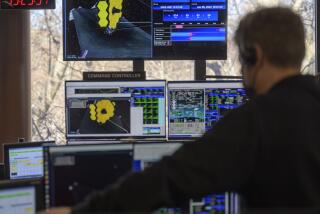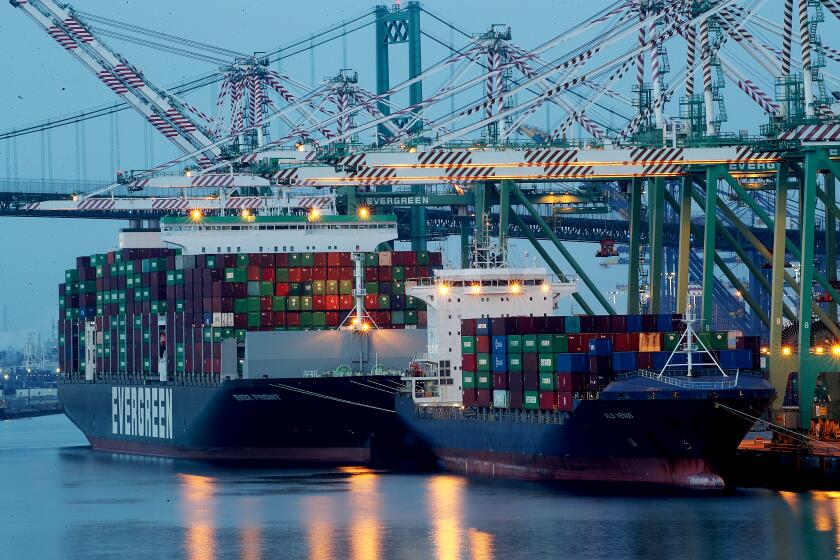Northrop Loss Means 21,000 Lost Jobs : Aviation: The Lockheed team’s winning of the advanced tactical fighter contract is the latest in a string of blows to the Southland’s aerospace industry.
The aerospace industry in Southern California lost big when the Air Force on Tuesday decided to give the $14-billion development contract for the advanced tactical fighter to a team led by Lockheed Corp.
The initial impact will be in the hundreds of jobs that will be eliminated by Los Angeles-based Northrop Corp., the Lockheed team’s vanquished competitor. But the decision also wipes out as many 21,000 future jobs in the state--mostly in Southern California--that would have been generated if Northrop had won, the company estimated.
Northrop’s defeat is the latest in a series of blows to Southern California’s aerospace industry, which has been reeling from layoffs at major contractors in the past two years as a result of greater worldwide competition, the defense budget crunch and the warming of the Cold War.
Northrop officials said layoffs and attrition will result in a reduction of up to 400 employees working on the YF-23, Northrop’s version of the fighter. Another 200 employees will likely be transferred to other work, they said.
“We’re disappointed, but from Northrop’s perspective we still have more than $6.5 billion in backlog in other programs, of which the largest is the B-2” Stealth bomber, said Kent Kresa, chairman and chief executive of Northrop. “We can now get this behind us.”
Still, observers say the potential jobs that the program promised make the loss devastating for Northrop--which had invested $245 million in the project since October, 1986--and its allies in Southern California.
An economic study by UCLA concluded that Northrop would have directly employed 6,000 workers over the 25-year life of the program and that other firms in California would employ an additional 11,000 to 15,000 workers.
“It is a tough thing for California,” Kresa acknowledged.
In Southern California, the Northrop loss could wipe out an estimated $500 million in personal income that would have been earned by workers directly or indirectly employed over the years by the ATF program, said David Hensley, acting director of the UCLA Business Forecasting Project.
“This is a big loss for Northrop,” Hensley said. “But I think the larger issue--given that Lockheed is building the plane in Georgia--is what this means for the relocation of manufacturing outside of the state.”
A Times survey earlier this year concluded that the Los Angeles region lost 18,000 aerospace jobs during the 1980s as firms left the state in search of lower labor costs, lower taxes, less stringent environmental regulation and lower costs of living.
Hensley said Northrop’s loss is also a blow to such ailing sectors of the local economy as retail and wholesale trade, which could have gained 3,000 to 4,000 jobs as part of the additional business thrown off by ATF manufacturing jobs.
Restaurants and business services near Northrop plants in Palmdale and Pico Rivera could suffer as a result of the Air Force’s decision, he added.
Embattled McDonnell Douglas Corp., a major partner on Northrop’s team, will lay off about 500 workers this year in St. Louis as a result of the ATF loss and the winding down of production of its F-15 Eagle fighter, which Lockheed’s new fighter will replace, said Jim Reed, a McDonnell spokesman.
The Air Force’s decision only piles more bad news atop the struggling aerospace giant.
McDonnell has had to lay off thousands with the cancellation early this year of the Navy’s A-12 attack jet program. And it came up the loser a few weeks ago when the Army selected a team of Boeing and Sikorsky to build a new helicopter. McDonnell does have three major, continuing military programs, however: a new version of its F-18 fighter, the Air Force’s C-17 cargo jet, which is built in Long Beach, and the T-45, a trainer jet under development for the Navy.
Reed said the company estimated that it would have generated 6,000 jobs during the life of the ATF program. Most would have been at a plant in St. Louis, where about 100 employees have been working on the project.
“It’s a disappointing outcome,” Reed said. “But we feel we have enough work” with programs such as the F/A-18 Hornet fighter, the C-17 cargo plane and the T-45 trainer aircraft, he said.
More than 60 subcontractors--including 14 firms in California--helped Northrop and McDonnell Douglas develop their fighter. A victory could have generated 28,000 jobs for those firms nationwide over the course of the program--jobs that will instead go to Lockheed’s team, which will do most of its hiring in Georgia, Texas and Kansas.
Tony Cantafio, spokesman for Northrop, said an estimated 1,500 jobs would have been generated for subcontractors in California by 1994.
Ten of those would have gone to Magna Mill Products, a small metal parts shop in South Gate with 40 employees.
“It’s bad for us that Northrop lost,” said Larry Sepulveda, program manager at the company. “It’s the kind of thing that could push us out of business.
Sepulveda said the company won’t lay off any employees, in part because it has some work from the Lockheed contractor team. But Sepulveda said the company’s work building bulkheads for the YF-23 could have generated a fifth of Magna’s revenue for years to come.
With Lockheed victorious, most of the jobs will go to its plant in Georgia and its partners’ plants in Kansas and Texas.
In the heated battle for the advanced tactical fighter contract, Parker Bertea Aerospace, an Irvine firm, was one of the few subcontractors on both of the competing teams.
But Parker is unlikely to add any jobs; ATF work will replace other contracts that are running down, explained Jim Lowes, a group vice president.
“This industry is hurting. And with the airplane being built in Georgia, perhaps it’s time we took a look at what California is doing to attract manufacturing business,” Lowes said.
LOCKHEED WINS
Lockheed beat out Northrop in the high-stakes contest to develop a futuristic fighter jet. A1
LOCKHEED’S TEAM: MAJOR SUBCONTRACTORS The companies that will work on the F-22 fighter are scattered across the country. They include: Allied-Signal Aerospace Co.
South Bend, Ind.
Curtiss Wright Flight Systems Fairfield, N.J.
Digital Equipment
Merrimack, N.H.
Dowty Decoto Inc.
Yakima, Wash.
EDO Corp.
College Point, N.Y.
Fairchild Defense
Germantown, Md.
GEC Avionics
Atlanta
General Electric
Utica, N.Y.
Harris Corp.
Melbourne, Fla.
Hughes-Radar Systems Group
Los Angeles
Kaiser Electronics
San Jose
Lear Astronics
Santa Monica
Lockheed Sanders Inc.
Nashua, N.H.
Menasco Inc.
Ft. Worth, Tex.
Motorola Inc.
Scottsdale, Ariz.
National Water Lift
Kalamazoo, Mich.
Parker-Hannifin Corp.
Irvine
Rosemount Inc.
Burnsville, Minn.
Simmonds Precision
Vergennes, Vt.
Sterer Engineering
Los Angeles
Texas Instruments
Dallas
TRW Avionics & Surveillance Group
San Diego
United Technologies
Hamilton Standard Division
Windsor Locks, Conn.
Westinghouse Electric
Baltimore
XAR Inc.
City of Industry
OVERSEAS Kidde-Graviner Ltd.
Slough, U.K.
Source: Lockheed
THE WINNING FIGHTER Lockheed’s F-22 advanced tatical fighter is designed to become the Air Force’s premier air-to-air combat jet, replacing the aging F-15 fighter, which has been in use since 1972 and was one of the workhorses of the Persian Gulf War. Specifications of F-22 prototype: Height: 17 ft., 9 inches Wingspan: 43 feet Fuselage: 64 feet, 2 inches Maximum speed: Mach 2-plus (more than twice the speed of sound) Cruising speed: Mach 1.58 Crew: One or two Special Features: Stealth: 40% of the aircraft will be made of composite plastics, which enable it to evade radar. Speed: Travels at suprsonic speed without afterburners, the fuel-guzzing devices older fighters usse for quick bursts of speed.Weapon: AMRAAM and Sidewinder air-to-air missiles. The missiles are dropped from the belly of the airplane, another Stealth feature. (Under-wing missiles show up on radar.) Maneuverability: Moveable engine exhaust nozzles, a design called “thrust-vectoring,” allowthe F-22 to change the direction its nose points at varying speeds. Job Impact: For Lockheed’s team leaders: About 7,000 jobs, divided among a Lockheed plant in Marietta, Ga., a General Dynamics plant in Ft. Worth and Boeing facilities in Wichita, Kan. For California: Nearly 5,000 subcontractor jobs. The Losers: Northrop and McDonnell Douglas. Northrop would have employed 6,000workers in Southern California. About 1,500 subcontractor jobs will be foregone in the Southland. The Los Angeles area will lose $500 million in extra personal income (in 1982 dollars).
More to Read
Inside the business of entertainment
The Wide Shot brings you news, analysis and insights on everything from streaming wars to production — and what it all means for the future.
You may occasionally receive promotional content from the Los Angeles Times.










